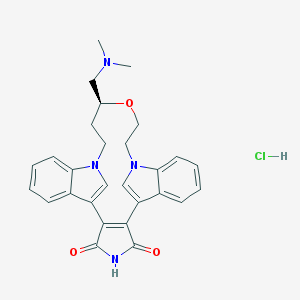| Description: |
Ruboxistaurin hydrochloride is a selective and ATP-competitive PKCβ inhibitor, with IC50s of 4.7 and 5.9 nM for PKCβI and PKCβII, shows less potent inhibition on PKCη (IC50, 52 nM), PKCα (IC50, 360 nM), PKCγ (IC50, 300 nM), PKCδ (IC50, 250 nM), and has no effect on PKCζ (IC50, >100 μM). |
| Target: |
PKCβI:4.7 nM (IC50)
PKCβII:5.9 nM (IC50)
PKCη:52 nM (IC50)
PKCδ:250 nM (IC50)
PKCγ:300 nM (IC50)
PKCα:360 nM (IC50)
PKCε:600 nM (IC50) |
| In Vivo: |
Ruboxistaurin (LY333531; 1 mg/kg/d for 8 weeks) markedly reduces GEC apoptosis as well as swiprosin-1 upregulation, and ameliorates renal glomerular injury in the diabetic mice. Ruboxistaurin also potently attenuates the expression of PARP, cleaved-caspase9, cleaved-caspase3, and the Bax/Bcl-2 ratio, in diabetic mice[3]. Ruboxistaurin (LY333531; 0.1, 1.0, or 10.0 mg/kg/d, po.o.) dramatically reduces the number of leukocytes trapped in the retinal microcirculation of diabetic rats[4]. |
| In Vitro: |
Ruboxistaurin hydrochloride is a selective and ATP-competitive PKCβ inhibitor, with IC50s of 4.7 and 5.9 nM for PKCβI and PKCβII, shows less potent inhibition on PKCη (IC50, 52 nM), PKCα (IC50, 360 nM), PKCγ (IC50, 300 nM), PKCδ (IC50, 250 nM), and has no effect on PKCζ (IC50, >100 μM)[1]. Ruboxistaurin (10 and 400 nM) dramatically inhibits glucose-induced monocyte adherence to levels that are not different from baseline adherence of monocytes to endothelial cells under NG conditions. Ruboxistaurin (10 and 400 nM) dose not alter the endothelial expression of adhesion molecules or modify endothelial cell growth[2]. Ruboxistaurin (LY333531; 10 nM) reduces high-glucose (HG)-induced human renal glomerular endothelial cells (HRGECs) viability, and inhibits the increases in swiprosin-1 in HRGECs incubated with HG[3]. |
| Cell Assay: |
The second passages of human umbilical vein endothelial cells (HUVEC) are grown to confluence in microtiter plates coated with gelatin. The medium contains 5.5 mM glucose. If endothelial cells are stimulated with 27.7 mM glucose for 4 days, they are seeded in the well at a calibrated higher cell concentration in order to achieve comparable cell density at the day adhesion assays are performed. Therefore, cell density in the wells is tested thoroughly in control wells of each glucose concentration prior to monocyte adhesion assays. If Ruboxistaurin is used in this assay, it is added to the cultures for the whole period[2]. |
| Animal Administration: |
Rats[4] Leukocyte entrapment is evaluated only once after a 4-week diabetic period in both groups of rats with and without Ruboxistaurin treatment, using one eye (right eye) of each rat. Ruboxistaurin is administered orally at dosages of 0.1 (n = 8), 1.0 (n = 16), and 10.0 mg/kg/d (n = 8) for 4 weeks, from the time streptozotocin is injected in the rats. Immediately before acridine orange digital fluorography, rats are anesthetized with a mixture (1:1) of xylazine hydrochloride (4 mg/kg) and ketamine hydrochloride (10 mg/kg). The pupils are dilated with 0.5% tropicamide and 2.5% phenylephrine hydrochloride. A contact lens is placed on the cornea to maintain transparency throughout the experiments. Each rat has a catheter inserted into the tail vein and is placed on a movable platform. Body temperature is maintained between 37°C and 39°C throughout the experiment[4]. |
| References: |
[1]. Jirousek MR, et al. (S)-13-[(dimethylamino)methyl]-10,11,14,15-tetrahydro-4,9:16, 21-dimetheno-1H, 13H-dibenzo[e,k]pyrrolo[3,4-h][1,4,13]oxadiazacyclohexadecene-1,3(2H)-d ione (LY333531) and related analogues: isozyme selective inhibitors of protein kinase C beta. J Med Chem. 1996 Jul 5;39(14):2664-71.
[2]. Kunt T, et al. The beta-specific protein kinase C inhibitor ruboxistaurin (LY333531) suppresses glucose-induced adhesion of human monocytes to endothelial cells in vitro. J Diabetes Sci Technol. 2007 Nov;1(6):929-35.
[3]. Wang ZB, et al. LY333531, a PKCβ inhibitor, attenuates glomerular endothelial cell apoptosis in the early stage of mouse diabetic nephropathy via down-regulating swiprosin-1. Acta Pharmacol Sin. 2017 Jul;38(7):1009-1023.
[4]. Nonaka A, et al. PKC-beta inhibitor (LY333531) attenuates leukocyte entrapment in retinal microcirculation of diabetic rats. Invest Ophthalmol Vis Sci. 2000 Aug;41(9):2702-6. |






















